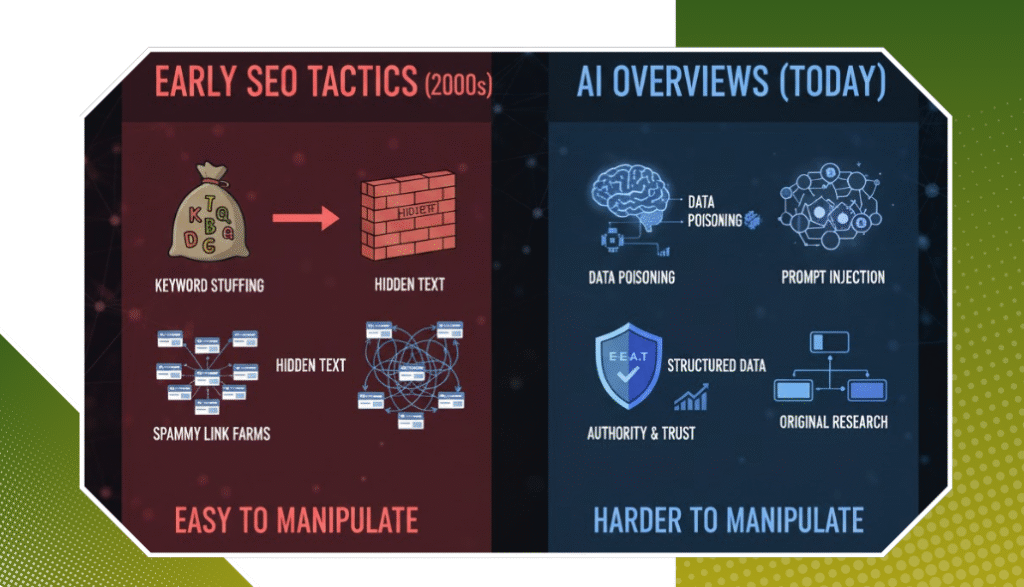What Are AI Overviews and How Do They Work?
AI Overviews, featured in Google’s Search Generative Experience, are the highlighted AI-generated summaries of search results designed to provide people with quick, concise answers at the top of the search page. The system is powered by Google’s advanced language models (such as the Gemini AI model) and is designed to provide quick, conversational answers at a glance. They synthesise information from several websites to provide a comprehensive answer, often including links to those sources for further exploration. While this sounds good for users, it has made it harder for websites to compete for clicks.
Google’s Official Stance on Optimised & AI‑Generated Content
Google has been clear that it values content quality and usefulness and does not penalise it simply because AI generated it. According to Google’s Search Central guidelines, content should be written for people, not search engines. It should provide real value and serve a clear purpose for readers. Pages stuffed with keywords, unnatural links, or copy-and-paste text are still under the spam rules. If your content is clearly written for the algorithm, it may be ignored or replaced in AI overviews. This is not a penalty in the traditional sense. Your site may still be indexed and ranked, but it may not be chosen for the AI summary, which can cut your traffic.
Are Over‑Optimised Pages Being “Penalised”?
Many SEO experts have noticed a drop in traffic from pages that used to rank well. It can certainly feel like a penalty when your well-optimised page suddenly gets fewer visits. However, in reality, AI does not ban over-optimised pages, but it changes how visibility works. AI overviews pull from sources that sound more natural and reader-focused. Even if your page ranks on the first page, it may not be included in the summary. Users might not click your result because the AI answer already addressed their question. Google is now favouring a different type of content. The new system rewards:
- Natural writing that sounds like it’s meant for a real person
- Clear answers to questions, without filler
- Pages that reflect trust and real expertise
So, if your content feels like it was written for bots rather than people, it may be overlooked.
SEO Best Practices to Avoid Penalisation & Influence AI Overviews
To keep your content visible and improve your chances of being featured in an AI Overview, here are some SEO best practices:
- Write for Humans First: Put your readers’ needs at the centre. Avoid keyword stuffing or repeating phrases too often. Provide depth, examples, or data. Use clear language and short sentences. Avoid repeating industry jargon.
- Use Clear Structure and Formatting: Structured content is key. Break up your text with descriptive headings (H2s, H3s) that reflect common questions or subtopics. Use numbered lists or bullet points to present steps and key points. Make sure each section answers a clear question. This helps both AI and users understand your page better.
- Provide Depth and Originality: Over-optimisation often fails on depth. Simply repeating generic advice that’s already on 10 other sites won’t impress Google’s AI. Instead, aim to add unique value or a fresh perspective. Include facts, examples, or insights drawn from your expertise.
- Demonstrate E-E-A-T (Experience, Expertise, Authoritativeness, Trustworthiness): In the era of AI Overviews, credibility matters. The AI is more likely to use content from sources that it perceives as authoritative and trustworthy. You can cultivate this by including author names and bios on your articles (showing the author’s expertise or credentials), citing your sources or references for factual claims, and keeping your site’s “About” and contact information transparent and up to date.
- Keep Content Up-to-Date: Outdated content may still rank, but it is less likely to appear in summaries. Regularly review your top-performing content to ensure it’s still accurate and the advice is still good. Up-to-date content not only serves your readers better but also informs Google that your website is active and maintained.
How to Find Out If Google Is Penalising Your Site
If your traffic suddenly drops, it may feel like a penalty, but it is not always the case. Start by checking Google Search Console. Go to the Manual Actions section to see if a reviewer has flagged your site. You should also watch for ranking drops on your key pages and compare the timing with recent Google updates. Tools like Ahrefs or Semrush can help you track keyword declines. You can also do a simple site search on Google using “site:yourwebsite.com” to check if your pages are still indexed. If everything seems fine there, the issue might be with how your content aligns with newer algorithm changes.
Conclusion
AI Overviews are reshaping the search landscape. They do not punish over‑optimised content in the sense of manual punishment. Instead, they give preference to content that clearly serves user intent. Over‑optimised pages can fall out of the summarised view. They may lose some visibility in AI searches. However, they still appear in traditional search listings. For small business owners and content marketers, the lesson is clear: it’s time to adapt. Focus on writing clear, helpful, and human-friendly content. If you want your content to align with what Google says it values, contact us at Rankingeek Marketing Agency!




